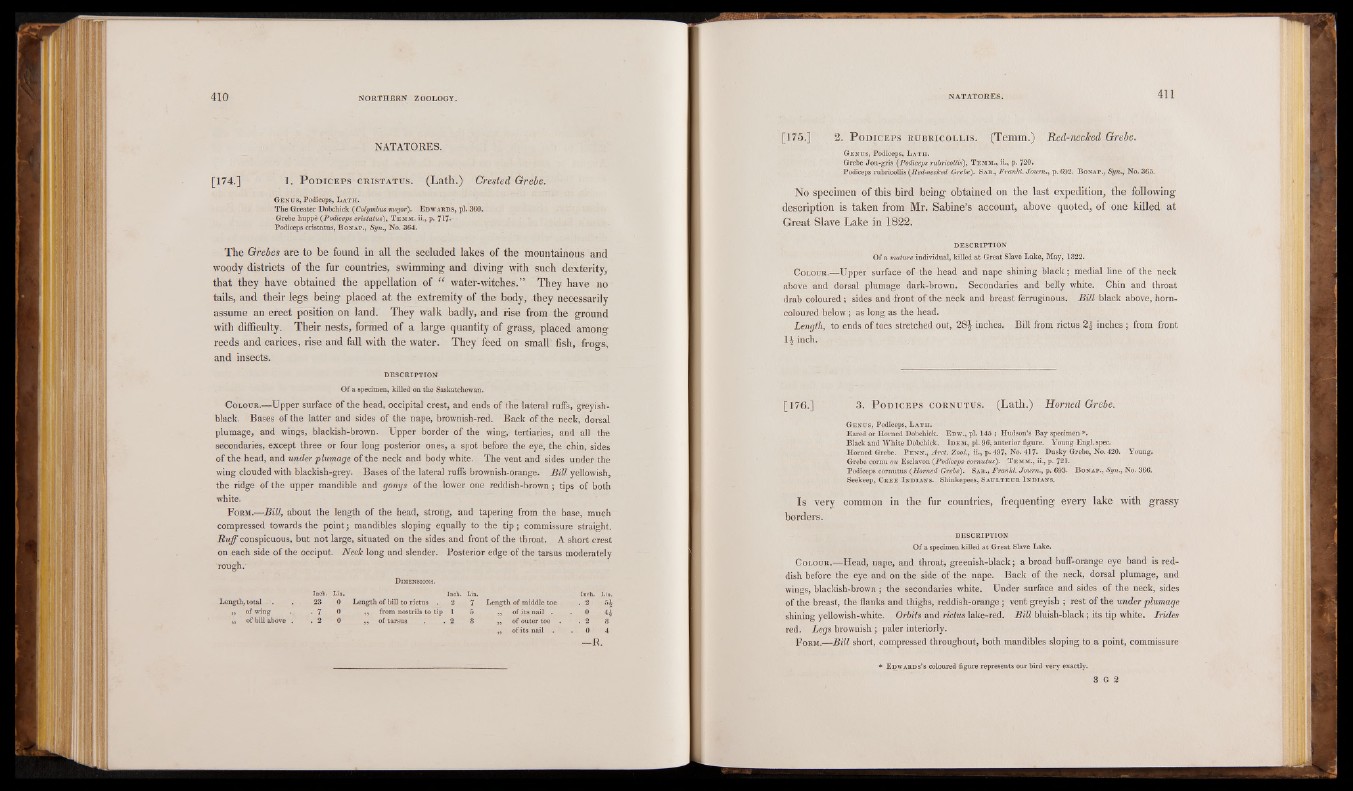
NATATORES.
[174.] 1. P o d i c e p s c r i s t a t ü s . (Lath.) Crested Grebe.
Ge n u s , Podiceps, L a t h .
The Greater Dobchick (Colymbus major). E dwards, pi. 360.
Grebe huppé (Podiceps cristatu-s), Temm. ii., p. 717«
Podiceps cristatus, B o nap., Syn., No. 364.
The Grebes are to be found in all the secluded lakes of the mountainous and
woody districts of the fur countries, swimming and diving with such dexterity,
that they have obtained the appellation of “ water-witches.” They have no
tails, and their legs being placed at the extremity of the body, they necessarily
assume an erect position on land. They walk badly, and rise from the ground
with difficulty. Their nests, formed of a large quantity of grass, placed among
reeds and carices, rise and fall with the water. They feed on small fish, frogs,
and insects.
DESCRIPTION
Of a specimen, killed on the Saskatchewan.
Colour.—Upper surface of the head, occipital crest, and ends of the lateral ruffs, greyish-
black. Bases of the latter and sides of the nape, brownish-red. Back of the neck, dorsal
plumage, and wings, blackish-brown. Upper border of the wing, tertiaries, and all the
secondaries, except three or four long posterior ones, a spot before the eye, the chin, sides
of the head, and under plumage of the neck and body white. The vent and sides under the
wing clouded with blackish-grey. Bases of the lateral ruffs brownish-orange. Bill yellowish,
the ridge of the upper mandible and gonys of the lower one reddish-brown; tips of both
white.
Form.—Bill, about the length of the head, strong, and tapering from the base, much
compressed towards the point; mandibles sloping equally to the tip ; commissure straight.
Ruff conspicuous, but not large, situated on the sides and front of the throat. A short crest
on each side of the occiput. Neck long and slender. Posterior edge of the tarsus moderately
rough.
Dimensions.
Inch. Lia. Inch. Lin. Inch. Lin. Length, total 23 0 Length of bill to rictus . 2 7 Length of middle toe . ,, of wing 2 m . 7 0 „ from nostrils to tip 1 5 .,, of its nail . 0 4i M of bill above . . 2 0 ,, of tarsus . . 2 8 ,, of outer toe . . 2 8 „ of its nail . - 0 4
[175.] 2. P o d i c e p s r u b r i c o l l i s . (Temm.)':; Red-necked Grebe.
Ge n u s, Podiceps, L a t h .
Grebe Jou-gris {Podiceps rubricollis), T em m ., ii., p. 720.
Podiceps rubricollis {Red-necked Grebe). Sab., Frankl. Joum., p. 692. B onap., Syn., No. 365.
No specimen of this bird being obtained on the last expedition, the following
description is taken from Mr. Sabine’s account, above quoted, of one killed at
Great Slave Lake in 1822.
DESCRIPTION
Of a mature individual, killed at Great Slave Lake, May, 1822.
Colour.—Upper surface of the head and nape shining black; medial line of the neck
above and dorsal plumage dark-brown. Secondaries and belly white. Chin and throat
drab coloured; sides and front of the neck and breast ferruginous. Bill black above, horn-
coloured below; as long as the head.
Length, to ends of toes stretched out, 28J inches. Bill from rictus 2\ inches ; from front
inch.
[176.] 3. P o d i c e p s c o r n u t u s . (Lath.) Horned Grebe.
G e n u s, Podiceps, L a t h .
Eared or Horned Dobcbick. E dw., pi. 145 ; Hudson’s Bay specimen *.
Black and White Dobcbick. Idem, pi. 96, anterior figure. Young Engl. spec.
Horned Grebe. P e n n ., Arct. Zool., ii., p. 497, No. 417- Dusky Grebe, No. 420. Young.
Grebe cornu ou Esclavon (Podiceps cornutus). Temm., ii., p. 721.
Podiceps cornutus {Homed Grebe). Sab., Frankl. Journ., p. 693. B o nap., Syn., No. 366.
Seekeep, Cb.ee I n d ia n s. Sbinkepees, Sa u l t e u r I n d ia n s.
Is very common in the fur countries, frequenting every lake with grassy
borders.
DESCRIPTION
Of a specimen killed at Great Slave Lake.
Colour.—Head, nape, and throat, greenish-black; a broad buff-orange eye band is reddish
before the eye and on the side of the nape. Back of the neck, dorsal plumage, and
wings, blackish-brown ; the secondaries white. Under surface and sides of the neck, sides
of the breast, the flanks and thighs, reddish-orange ; vent greyish ; rest of the under plumage
shining yellowish-white. Orbits and rictus lake-red. Bill bluish-black; its tip white. Irides
red. Legs brownish ; paler interiorly.
Form.—Bill short, compressed throughout, both mandibles sloping to a point, commissure
* Edwards’s coloured figure represents our bird very exactly.